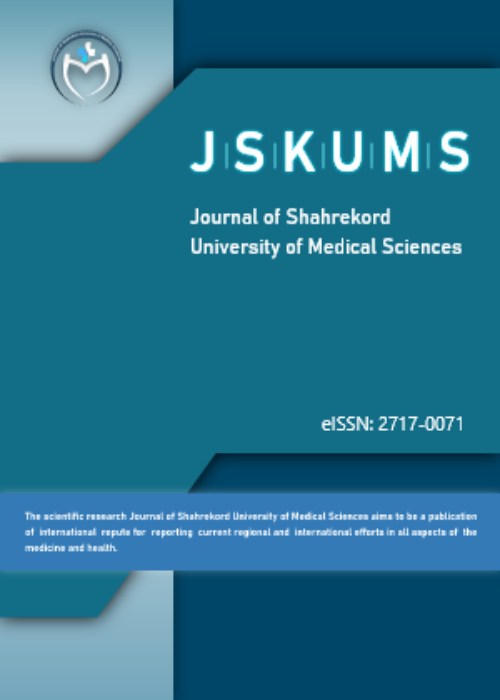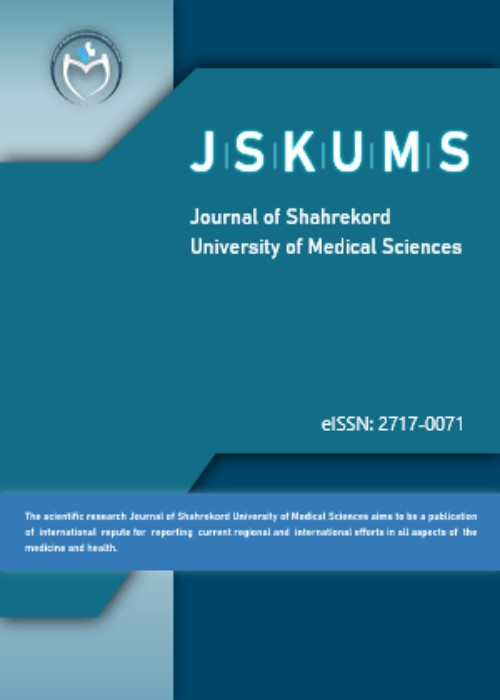فهرست مطالب

مجله دانشگاه علوم پزشکی شهرکرد
سال بیست و پنجم شماره 3 (پیاپی 120، Summer 2023)
- تاریخ انتشار: 1402/06/11
- تعداد عناوین: 9
-
-
Effect of watercress seed mucilage (Lepidium sativum L.) on the wound healing in New Zealand rabbitsPages 115-123Background and aims
Wound healing is one of the most important issues in medical science. Synthetic drugs have long been introduced and used to speed up the healing process of wounds, but most of them have many side effects. The present study was performed to evaluate the healing efficiency of watercress seed mucilage (Lepidium sativum L.) on wounds.
MethodsIn this study, the animals were randomly divided into five groups. The treatment groups were (1), (2), (3), sham (4), and control (5). The treatment groups were treated with 20%, 10%, and 5% watercress seed mucilage in the Eucerin base, respectively, and the sham was treated with Eucerin, while the control received no treatment. Then, 5 pairs of full-thickness wounds with a diameter of 7 mm were created on both sides of the rabbit’s spine. Macroscopic and wound area studies were performed on days 4, 7, and 14 after surgery.
ResultsAccording to the analysis of variance, there was a significant difference between groups 1, 2, 3, sham, and control (P = 0.001), but no significant difference was observed between group 3, sham group, and control group (P = 0.993). Based on these findings, at the end of the treatment period, group 1 had the highest healing rate and the lowest wound area (1.12 ± 0.77) compared to group 2 (4.42 ± 0.30) and 3 (7.05 ± 0.35), as well as the sham (8.34 ± 1.10) and control (8.50 ± 1.90) groups. Thus, the treatment method of this group has been more effective in wound healing than that of the other treatment groups.
ConclusionIt seems that watercress seed mucilage can treat wounds due to its important compounds such as flavonoids, phenols, and vitamins A and C.
Keywords: Mucilage, Lepidium sativum seed, Wound healing, Surgery -
Pages 124-129Background and aims
Muscle atrophy is a complication of type 2 diabetes, in which the expression of atrophy-related genes is increased. The present study aimed to investigate the effect of high-intensity interval training (HIIT) and metformin on gene expression of two atrophy-related genes (i.e., FoxO1 and Atrogin-1) in the skeletal muscle of diabetic mice.
MethodsA total of 30 mice (C57BL/6) were assigned to two groups: control (n = 6), and high-fat diet (HFD) (n = 24). The mice in the HFD group were fed a HDF for 16 weeks. Then, diabetes was induced in mice by HFD. Then, they were divided into 4 groups as follows: (i) diabetic control, (ii) diabetes + metformin (DM), (iii) diabetes + HIIT (DH), and (iv) diabetes + metformin + HIIT (DMH). The DM group took metformin, the HIIT group performed a HIIT program, and the DMH group had both HIIT and metformin. The real-time PCR methods were used to measure the mRNA expression of FoxO1 and Atrogin-1.
ResultsThe findings showed that HFD-induced diabetes caused increases in the expression of FoxO1 (P = 0.0006) and Atrogin-1 (P = 0.0008), and HIIT could restrain these increments (P = 0.086, P = 0.041). However, the decreasing effect of metformin on the expression of these genes was not significant (P = 0.15) and the combined effect of HIIT and metformin on the expression of these genes was not greater than the individual effect of HIIT (P = 0.64).
ConclusionThese results indicated that HIIT (but not metformin) may prevent type 2 diabetes-induced downregulation of FoxO1 and Atrogin-1 in skeletal muscle, and metformin could not affect the impact of the training on these atrophy-related genes.
Keywords: Metformin, HIIT, FoxO1, Atrogin-1, Diabetes -
Pages 130-136Background and aims
Diabetic cardiomyopathy (DCM) is a major cause of morbidity and mortality among diabetic patients. This study aimed to compare and investigate the effects of high-intensity interval training (HIIT) and moderate-intensity continuous training (MICT) on oxidative stress as one of the key links in the development of DCM in mice with type 2 diabetes mellitus (T2DM).
MethodsForty male C57BL/6J mice were randomly assigned to four groups of equal number (Control, T2DM, T2DM + HIIT, and T2DM + MICT). After the induction of T2DM, HIIT and MICT programs were conducted 5 days a week for 8 weeks. At the end of the experimental period, blood and heart samples were collected for subsequent measurements.
ResultsT2DM significantly up-regulated the levels of advanced glycation end products (AGEs, P = 0.001) and the expression of 15-lipoxygenase (15-LOX, P = 0.001) and 4-hydroxy-2-nonenal (4-HNE, P = 0.001) compared to controlled mice. After 8 weeks of training, HIIT and MICT programs increased the levels of insulin (P < 0.001) while reducing the levels of fasting blood glucose (P < 0.001, P = 0.024, respectively). On the other hand, it was found that HIIT and MICT programs significantly decreased the levels of AGEs (P < 0.001), expression of 15-LOX (P = 0.006, P = 0.019, respectively), and 4-HNE (P = 0.008 and P = 0.035, respectively).
ConclusionOur findings revealed that exercise training, particularly MICT, will be highly helpful in the prevention of DCM through the improvement of glucose metabolism and reduction of 15-LOX expression.
Keywords: Type 2 diabetes mellitus, Diabetic cardiomyopathy, Exercise, Oxidative stress -
Pages 137-142Background and aims
Chlorpyrifos (CPF) is an insecticide that is widely used in the world. The purpose of this research was to investigate the effect of 4-week aerobic exercise and eugenol supplementation on the phosphatidylinositol-3-kinases/protein kinase/mammalian target of rapamycin (Pi3K/AKT/mTOR) pathway on the skeletal muscle of male rats poisoned with CPF.
MethodsOverall, 12-week-old female rats were used in this experimental research. The rats were randomly divided into 8 groups (8 rats in each group), including healthy control, toxic control, poison solvent, corn oil solvent, poisoned + eugenol, poisoned + aerobic exercise, and poisoned + aerobic exercise + eugenol. Moderate training was in the range of 50-60% VO2max, including 5 training sessions per week (treadmill). Poisoning was performed with CPF poison with a dose of 3 mg/kg, and the dose of eugenol was determined to be 250 mg/kg.
ResultsThere was no significant difference between the groups in terms of mTOR and AKT expression (P = 0.369, P = 0.59). However, the expression of PI3k in the poisoned control group was lower than that in the healthy control group (P = 0.049). In addition, the expression of PI3k was higher in the poisoned + eugenol + exercise group compared to the poisoned control group (P = 0.009). The corn solvent group also had a higher PI3k expression in comparison to the poisoned control group (P = 0.025). Finally, there was no significant difference among the other groups.
ConclusionIn general, 4 weeks of CPF poisoning caused a significant decrease in PI3K, but it did not have a significant effect on AKT and mTOR. Based on the finding, 4 aerobic exercises and eugenol consumption could significantly increase in PI3K, while it had no significant effect on AKT and mTOR.
Keywords: Pesticide, Aerobic exercise, Chlorpyrifos, PI3K, AKT, mTOR -
Pages 143-148Background and aims
Tramadol and methadone are synthetic opioid drugs that are widely used in various fields of medicine. This review article was performed to investigate the hormone disturbance of long-term tramadol and methadone use in women.
MethodsKeywords were determined using the MeSH browser and then searched in ISI, Scopus, EMBASE, and PubMed databases on 25.5.2022. The articles with non-English language, articles whose full text was not retrieved, and studies that were irrelevant to the aim of this study were excluded from the investigation.
ResultsMethadone and tramadol affected a sexual hormone in women through an impact on the hypothalamic-pituitary-gonadal axis. They could reduce the levels of follicle stimulating hormone and luteinizing hormone, increase prolactin production, and finally, reduce gonadal steroids. Opioids also could influence thyroid and adrenal glands and subsequently increase thyroidstimulating hormone, and reduce dehydroepiandrosterone. Eventually, this mechanism caused a disturbance in sexual hormone disturbance in women.
ConclusionOverall, long-term methadone and tramadol consumption as opioid substances could cause sexual hormone disturbance in women.
Keywords: Methadone, Tramadol, Sexual, Sex hormone, Women -
Pages 149-155Background and aims
Osteoarthritis (OA) is the most common skeletal and excruciating disease worldwide. This study aimed to investigate bromelain’s effect and underlying mechanism on OA symptoms.
MethodsThis systematic review was designed according to the PRISMA guidelines. An extensive search was undertaken in various databases, including PubMed, Web of Science, EMBASE, and Scopus. Finally, 14 articles were retrieved considering the inclusion and exclusion criteria of the study. The desired data were extracted and entered into an Excel file, and the outcomes of the studies underwent investigation.
ResultsBromelain downregulates inflammatory cytokines such as tumor necrosis factor (TNF)-α, interleukin 6 (IL-6), IL-8, IL- 1β, and interferon γ expression in synovial fibroblasts. In addition, bromelain inserts analgesic effects by decreasing vascular permeability to bradykinin and inhabitation its generation. Bromelain counteracts by increasing the levels of TNF-α, IL-1β, inducible nitric oxide synthase (iONS) levels, and lipid peroxidation while reducing those of superoxide dismutase, catalase, and prolidase. Another main antinociceptive effect property of bromelain is associated with its anti-inflammatory effect by relieving neuroinflammation and synovial membrane inflammation.
ConclusionBromelain indicated good therapeutic effects on reducing OA symptoms due to its anti-inflammatory and antioxidant effects. Although no specific bromelain-related side effects were not reported in the included studies, it is recommended that more laboratory studies should be conducted with different doses and appropriate methodology.
Keywords: Bromelain, Osteoarthritis, Arthritis, Systematic review -
Pages 156-158
For better management of acute kidney injury (AKI) and prevention of progressive renal injury, it is extremely important to manage infections such as gastroenteritis. In addition, anuria is considered a risk factor for AKI and even causes death in patients. An 18-month-old boy with vomiting and diarrhea for three days and anuria for 24 hours was referred to Farsan hospital. The patient had bulky and watery diarrhea about 7-8 times a day and vomited 3-4 times a day which was containing food particles. He had a fever on the first and second days. Ultrasound findings revealed that the right kidney did not exist, and the left kidney was affected by compensatory hypertrophy. Disorders in the patient’s blood biochemical factors were also observed. Acidosis and other biochemical disorders were treated with bicarbonate drip, allopurinol, Lasix drip, and dopamine drip. After about 18 hours, anuria was treated.
Keywords: Anuria, Acute kidney injury, Solitary kidney, Gastroenteritis -
Pages 159-160


